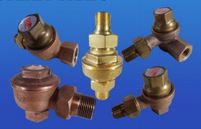 How to diagnose a leaking steam trap
How to diagnose a leaking steam trap
November 27, 2014 REDWIRE is news you can use from leading suppliers. Powered by FRASERS.
Posted by Keystone Steam Supplies
Exclusive Canadian stocking distributor of “Edison” steam traps and repair kits (for all manufacturer’... Read more
Subscribe
Free REDWIRE e-newsletter

Steam traps have a tendency to leak. A faulty steam trap not only wastes valuable heating dollars, but it can also destroy condensate pumps, create hot and cold spots within a heating space, cause production inefficiency of process equipment, produce destructive water hammer, and lead to undue wear on, and premature failure of, other traps.
How do you know if you have leaking steam traps? Checking your condensate return pumping unit is a good start. If there is steam coming out of the vent under pressure (not flash steam), that is a good indication that you have one — and probably more than one — leaking trap.
Common methods of checking traps
Temperature: Some people feel that a hot return line from the trap indicates a leak. This is not true. A trap that is cycling properly will discharge condensate near saturated steam temperature. The return line will also be hot.
Temperature differential: Many people use a temperature probe to take a reading immediately before a trap and immediately after the trap. The theory is that there should be a dramatic temperature differential between the two readings to determine if the trap is working, or little temperature differential, which would indicate the trap has failed. Sometimes this works. However, if there are multiple traps within close proximity to one another and all are sending condensate to a common collection pipe, and if just one of those traps has failed in the open position (common), the steam will back up into the other outlet pipes causing a false reading.
Observation: Only when observing the discharge from the traps can you determine whether the trap is cycling properly and if it closes tightly. To do this in a closed system, it is necessary to valve the discharge at each trap so the discharge from that trap is isolated from the rest of the system and the condensate is dumped to atmosphere from the trap body. This can be accomplished with float and thermostatic traps, and with bucket traps.
Installed systems: Several systems exist where test chambers are installed at critical steam trap locations, which continuously monitor the performance of the associated steam trap. Some of these systems can be wired to a remote facility so that real-time performance can be observed and/or recorded. Other systems require that the test chambers be checked manually with a probe to determine the performance of the trap.
Ultrasonic: This is the most convenient and least intrusive method of locating faulty steam traps. Why? An ultrasonic steam trap leak detector converts and amplifies the 35,000 to 45,000 cycles per second that leaking steam traps generate to frequencies that can be heard by the human ear. The user can hear and evaluate whether the sound is normal or abnormal based on his/her real world experience. A good steam trap sounds one way, and a faulty steam trap sounds another. Click here to find out more about this technology.
For more information about leak detection products and services, contact Keystone Steam Supplies.
Share
Posted by Keystone Steam Supplies
Exclusive Canadian stocking distributor of “Edison” steam traps and repair kits (for all manufacturer’... Read more